- milford@wildlifeanimalcontrol.com
Call 24/7 for a free quote:
302-246-5563
Milford Wildlife Animal Control
Professional Wildlife Removal Company Servicing Milford, DE
If you have a problem with wildlife in your Milford home, your best option is to hire a company that specializes in Delaware wildlife removal only. This is a specialty business, and regular pest control companies do not use the proper techniques to solve animal problems. I have spent many years reviewing Delaware and Milford, and I recommend the following:
Wildlife Removal Delaware
Cell Phone: 302-246-5563
NOTE: If you have a dog or cat problem, call Sussex County Animal Services: 302-255-4646

Wildlife Removal Delaware specializes primarily in removing animals from attics of homes and buildings - this includes squirrels in attics, raccoons, and rats or mice in homes. Delaware also has a documented problem with
bats in buildings, and Wildlife Removal Delaware is specially trained in bat removal. They also perform general wildlife trapping services, such as the capture and removal of skunks or opossums on the
property. Call 302-246-5563 to discuss your critter problem and schedule a same-day or next-day appointment. Click here to learn more about what prices we charge in 2020.
When hiring a company to solve your wild animal problem, you want these features:
- Specializes in wildlife removal, not pest control
- Fully Delaware and Sussex County licensed and insured
- Works 7 days per week (critters don't take weekends off)
- Performs full building inspections: enters and inspects attic
- Performs exclusion repairs, with guarantee against animal re-entry
- Offers cleanup of biohazardous wildlife waste
Wildlife Removal Delaware is a full-service Milford wildlife removal company. This is very different from a regular Milford pest control company. The pest control companies spray poison to kill insects. This is not at all
similar to wildlife removal. Wildlife Removal Delaware performs a full inspection of the home or property, and determines why the animal(s) are there, and if inside a building, how the animals got inside. All
animals (including rodents) are trapped and removed, or if possible, removed from the building using special exclusion devices. Once the animals are gone, preventative repairs are essential, and
cleanup is sometimes recommended.
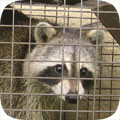 Milford wildlife trapping - it's not as simple as it may seem. It's illegal in Delaware to trap without a license. Trap type is very important and there are many different types, bait is somewhat relevant, trap placement
is vital, and there are dozens of small things that are very important to know.
Safety is a concern. Then once the animal is trapped, it must be removed and dealt with in the proper manner according to Delaware law. We offer Milford raccoon removal. Read more about how to get rid of raccoons.
Milford wildlife trapping - it's not as simple as it may seem. It's illegal in Delaware to trap without a license. Trap type is very important and there are many different types, bait is somewhat relevant, trap placement
is vital, and there are dozens of small things that are very important to know.
Safety is a concern. Then once the animal is trapped, it must be removed and dealt with in the proper manner according to Delaware law. We offer Milford raccoon removal. Read more about how to get rid of raccoons.
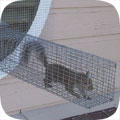 Animals in attics - this is our specialty at Wildlife Removal Delaware. Many types of animals like to live in attics. This includes squirrels, raccoons, rats, mice, bats, birds, and even possums. Critters like to go into attics for a safe place to live
and raise their young. Removing animals from attics is very complex work, partly because of the presence of baby animals. If you need Milford squirrel removal, we can remove all the squirrels from your attic, and seal out any future ones. Read more about how to get rid of squirrels.
Animals in attics - this is our specialty at Wildlife Removal Delaware. Many types of animals like to live in attics. This includes squirrels, raccoons, rats, mice, bats, birds, and even possums. Critters like to go into attics for a safe place to live
and raise their young. Removing animals from attics is very complex work, partly because of the presence of baby animals. If you need Milford squirrel removal, we can remove all the squirrels from your attic, and seal out any future ones. Read more about how to get rid of squirrels.
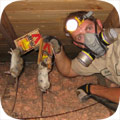 Rodent control must be done in a very specific way. First off, the most important thing is that all the openings that rats and mice can use to enter a house be sealed. Then all the rodents must be physically trapped and removed.
Never, ever use poison! Most Milford exterminators will just use this lazy poison technique to kill rodents, and it causes more harm than good - dead stinky rats, and it doesn't solve the problem. Call us for correct Milford rat removal. Read more about how to get rid of rats.
Rodent control must be done in a very specific way. First off, the most important thing is that all the openings that rats and mice can use to enter a house be sealed. Then all the rodents must be physically trapped and removed.
Never, ever use poison! Most Milford exterminators will just use this lazy poison technique to kill rodents, and it causes more harm than good - dead stinky rats, and it doesn't solve the problem. Call us for correct Milford rat removal. Read more about how to get rid of rats.
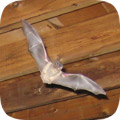 Bat removal is a highly specialized task. Delaware is known to have colonizing bats who often live in buildings. Bats love attics. If not removed, the colony can grow to a very large size over the years. The bat droppings are often corrosive and
cause health risks. The same goes for bird droppings on or in buildings. We perform Milford pigeon removal and bird control. But our specialty is Milford bat removal. We remove 100% of the bat colony and seal the building so that it's totally bat-proof. Read more about how to get rid of bats.
Bat removal is a highly specialized task. Delaware is known to have colonizing bats who often live in buildings. Bats love attics. If not removed, the colony can grow to a very large size over the years. The bat droppings are often corrosive and
cause health risks. The same goes for bird droppings on or in buildings. We perform Milford pigeon removal and bird control. But our specialty is Milford bat removal. We remove 100% of the bat colony and seal the building so that it's totally bat-proof. Read more about how to get rid of bats.
 If you have animals inside a house, no job is complete without proper exclusion repairs. If you simply hire a Milford trapper who only removes the critters, then the problem will return. You need to hire a Milford wildlife control company that identifies 100% of the animal entry points
into your building, and seals them shut with professional repairs. In addition, in many cases animals have left waste or contamination behind, and you'll want a company that can provide professional cleaning services. Wildlife Removal Delaware does both.
If you have animals inside a house, no job is complete without proper exclusion repairs. If you simply hire a Milford trapper who only removes the critters, then the problem will return. You need to hire a Milford wildlife control company that identifies 100% of the animal entry points
into your building, and seals them shut with professional repairs. In addition, in many cases animals have left waste or contamination behind, and you'll want a company that can provide professional cleaning services. Wildlife Removal Delaware does both.
The above are just some of the services offered by Wildlife Removal Delaware. We also trap and remove animals that destroy lawns, such as moles, or digging animals. Sometimes animals like opossums will live under buildings, steal pet food, raid garbage cans, etc.
Read about how to get rid of opossums. Skunks commonly live under sheds or decks, and set up a den. We can trap and remove them without them spraying. Read about how to get rid of skunks. Wildlife Removal Delaware
also provides dead animal removal in Milford. If you need help with any other wildlife conflict, from a fox, beaver, groundhog, or any other critter, we can solve it. We also do Milford snake removal - most of the snakes in Delaware are not venomous, but
call us if you want safe removal, or read about how to get rid of snakes in Milford. And remember, we are a private business, not Sussex County Animal Control Services, so if you have a dog or cat problem, call the County at 302-255-4646.
Sussex County animal services does not handle any wildlife issues.
Wildlife Removal Delaware: 302-246-5563
Milford Pricing Info For Year 2020
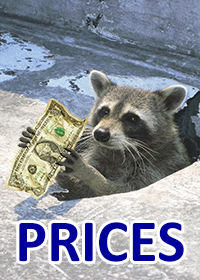 Every wildlife removal situation is different, from the species of animals involved, the location of the animal inside a house or outside, the extent of repairs or cleanup, etc. It's impossible to give one-size-fits-all prices. Examples MIGHT include:
Every wildlife removal situation is different, from the species of animals involved, the location of the animal inside a house or outside, the extent of repairs or cleanup, etc. It's impossible to give one-size-fits-all prices. Examples MIGHT include:
Small Job: For example, a one-stop job to remove an animal in the yard: $100 on up
Medium Job: For example, getting critters out of your house with minor repairs: $300 on up
Large Job: For example, a project involving many service trips and complex work: $500 on up
Give us a phone call now and tell us about your wildlife issue and we will be able to give you a price estimate over the phone. If you're cool with it, we can schedule a same-day or next-day appointment if you like. Our prices are fair, and a good value because we do the job right, the first time.
Milford Wildlife Tip #1:
WHAT IS A SNARE TRAP?
Traps are an ancient method used for catching game, small animals and furbearers. There are innumerable types of traps, and each civilization has developed their own traps and styles of hunting.
Snare traps, as the name suggests, are traps that snare or catch animals using a noose and a thin wire or cord. They are easily made and installed, lightweight and perfect for carrying long distances. Today you can use a snare trap to catch small animals or vermin, or hunt small game if you are out camping. Please be sure to check with local authorities first as some methods of hunting, or hunting itself, may not be permitted in your area.
Modern day snare traps are made with thin tightly wound steel cables and are around 5-7 feet long. They have a big loop or noose on one end with a small and sensitive locking mechanism that will activate when the animal touches it. On the other end, it has a small loop of twisted cable to allow it to be anchored safely to a post or tree.
The snare trap is then installed in an area where the target animal is most likely to travel through. This is determined by looking for footprints and animal droppings. The snare is propped up to the approximate height of the animal's head and left alone so that animals will freely approach the trap. If the animal senses a human is close or can perceive its scent, chances are it will probably choose a different path to wander.
Whether you are setting up snare traps for hunting, or for catching vermin, it is imperative you check your traps. A snare trap will immediately kill the animal, because the noose with cut off all circulation of blood and air to and from the head and neck, or it will break the neck bones of the animal. Snare trappers are required by law to check their traps every 24 hours. This is to minimize any suffering and animal may go through in the slim chance that it survives the initial trapping. It is also in your best interest to check the trap constantly to avoid it being eaten by another animal or to prevent the dead animal from starting to decay, as this will make it unsuitable for human consumption.
Always approach the dead animal with gloves, and treat it with respect. Remember that you are invading its territory and must use all natural resources wisely and sparingly. The goal when hunting is survival, not destruction, so a hunted animal must be used as much as possible. If you are hunting vermin close to your home, be sure to dispose of the dead body as cleanly and quickly as possible to avoid bad smells, decay and attracting other animals.
Milford Wildlife Tip #2:
Delaware Wildlife Information:
Delaware has about 800 different species of wildlife and in 2015 the U.S. Fish and Wildlife Service approved an action plan created by the state to protect local fish and animal species with conservation efforts. Not only do animals receive direct care, their natural habitat is conserved for future generations.
You can always call Wildlife Removal Delaware, any time of day, at 302-246-5563, for a price quote for Milford wildlife control services. I am confident that this is the best choice amongst wildlife removal companies in Milford, DE.





































